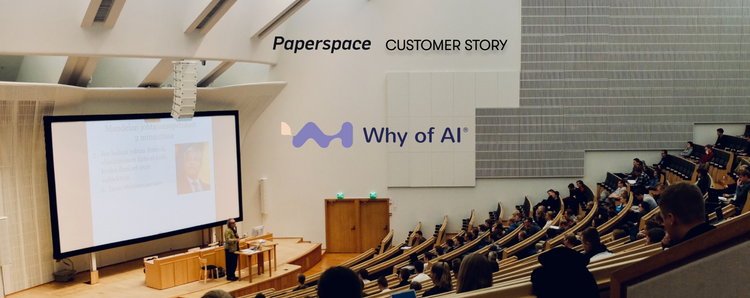CyberLayerVR’s Founder and CEO Bo Layer is constructing something that is incredible: an arena-scale virtual reality experience that sounds like a mashup between the OASIS and laser tag.
We were eager to learn from a subject matter expert at the forefront of VR, gaming, and machine learning -- and to see how he’s bringing multiple technologies together to create an innovative gaming experience.
Uniting physical and digital worlds is one of the most exciting ideas in tech today. We couldn’t wait to sit down with Bo to learn more about his ideas and development. What exciting new experiences will CyberLayerVR open? What technologies will enable these experiences? And when can we jump into the arena?
Bring this project to life
Paperspace: CyberLayerVR’s website is advertising “Competitive arena-scale VR”. Can you please confirm that this is exactly as cool as it sounds?
Layer: Confirmed! Of course there's a lot to unpack. Let’s take a look at each part and explain what it means in our context:
Competitive: We see our arenas as a proof of concept for the next generation of eSports athletes and gamers alike. This isn’t your run-of-the-mill shooting gallery but rather an entire world designed to push you as a player -- from your mental toughness to your physical fitness. The game world remembers everything and will push you harder as you progress.
Arena-scale: Just as in many other team sports, being able to move freely in a large environment filled with other physically co-located players is an important part of the program. The vision is to have players join the arena as they please, and play for as long as they like. A bit like a gym but for gamers.
VR: Virtual reality is the final medium for expressive and immersive entertainment. It’s what we’ve all been waiting to experience since the first radio broadcast voice and the first television displayed frames of film. What's a better place to bring gamers together?
Paperspace: Wow. Ok -- so you’re really merging the categories of digital and physical gaming. What will the gaming experience actually be like? Can you take us through the user experience at a high level?
Layer: For now, the gameplay is extremely simple. It is different every single time, as we have procedurally generated levels for you and your friends to battle inside. This includes maps such as aircraft hangars and city streets. We currently offer a three versus three user experience, which allows our players to duke it out and win by eliminating their opponent. It’s free play for a set amount of time currently, which will be either a half-hour or hour slot, depending on each group's needs.
Paperspace: With so many technical components we have to ask -- what is your background? Can you tell us how someone ends up with the skills to design something as multithreaded as CyberLayerVR?
Layer: My professional background falls into three main areas: general tech support, communications, and data science. I have nearly two decades of experience working with large companies such as Apple and Autodesk, and smaller startups such as the recently acquired cybersecurity firm, Shape Security. Finally, I learned about how the world connects together (both literally and figuratively) while in the Army and working alongside the Department of Defense.
Much of my time in the military and DoD was spent overseas between Iraq and Afghanistan where I learned what it was like to be almost entirely disconnected from the rest of the world. While in the Middle East, my childhood love for gaming began to flourish as I began to see how gaming could bring people together.
After returning to the United States and working in Silicon Valley I became obsessed with the idea that an immersive game could drive truly meaningful life experiences -- experiences that you remember and that contribute to your personality and character.
It’s no surprise that CyberLayerVR is at the intersection of a bunch of my interests and professional experience. I’ve worked in computer networking and data science, and I’ve researched the latest technologies in VR, volumetric motion capture, physical sensors, cloud-connected cognitive services, and computer vision fields to come up with the first generation of our eSports-ready competitive gaming platform.
Paperspace: What was the moment you figured out that this could work?
Layer: Two years ago I attended Facebooks’s yearly VR conference, Oculus Connect, and went to the demo for the newly introduced Quest headset. I was about to skip the demo when a friend of mine who was working with Facebook's CTO noticed me and helped me skip the line. Talking to the Facebook engineering team that day changed my entire life in 20 minutes. In the future I hope our work at CyberLayerVR will be equally inspiring to future founders.
Paperspace: What is the set of technologies that are enabling CyberLayerVR to happen right now? Could CyberLayerVR work five years ago? What can you tell us about the tech underneath the platform?
Layer: Virtually half of the tech that’s enabling us to build our (physical) eSports platform right now wasn’t even around eighteen months ago -- some even less than nine months ago!
This includes all-in-one VR headsets (no PC required), cloud-connected imaging sensors, wireless haptic feedback accessories, eye-tracking, full-body volumetric capture stages, high-resolution computer vision-enabled cameras, wireless biometric sensors including heart rate and neural signals…the list goes on and on.
Our platform enables on-location users to be full-body tracked across thirty-plus points/joints on their body, all without wearing a single marker (like wrist/feet bands with small trackers). This capability is a huge leap forward in tracking multiple humans in a single physical location with a relatively low cost.
For underlying tech, we are using off-the-shelf components such as the aforementioned Oculus Quest from Facebook, Microsoft and Intel depth sensors, bHaptics haptic feedback vests, and massively powerful gaming rigs from NZXT to power each location.
Paperspace: Can you tell us a little bit about why you chose Paperspace for your virtual machine setup? What is Paperspace enabling you to do that you couldn’t do before?
Layer: We need access to powerful cloud-connected machines with a vast amount of physical video memory, as well as huge amounts of standard memory coupled with a strong CPU.
Applications we may use in a single workflow at any given time can be upwards of ten to twelve.
When looking for GPU-enabled virtual machines that were geared toward professional power users, Paperspace was the only name that consistently showed up -- and with amazing reviews to boot.
We need all the power we can get, no matter our location. This is because we're running upwards of ten to twelve workflows, as well as running multiple applications to process the volumetric capture data to the game engine to our near real-time character creation flow. Paperspace meets all of our needs and then some.
I also stream my own personal games from Paperspace and have used it to host social meetups in VR (which successfully hosted 100 concurrent users on a server.
Paperspace: Will machine learning become an important part of your tool stack over time? How so?
Layer: Machine learning is going to a huge aspect of our platform. We will be using anonymized user tracking data taken from our games in order to train ML models for items such as smart/reactive AI opponents.
Ultimately, the goal is to have an AI bot make decisions based on anonymous user movement data from previous games and matches with players of similar skill level. This will be an exciting challenge for our gamers as they will need to overcome an AI that is trained on their own behavior! Aspirationally we want you not to be able to tell the difference between a real live human player and a computer-controlled opponent until you look away from the game and into the psychical arena itself at the player.
Paperspace: What are the next iterations of this project? Are you going to build new VR arenas and stories?
Layer: We are currently building three on-location-only experiences: a player-vs-player battle game, an escape-the-aliens type adventure, and a zombie wave group shooter. Eventually, all the experiences will exist in one space, just like the OASIS, and all will be enjoyable in their own right. At this time, we will be opening our first location in the Salt Lake City, Utah area and then expanding to surrounding areas.
We are currently testing the capability of adding remote users for additional backup in the on-location arena games. The online component is actually up and running as of a few nights ago! Our website will have the latest updates and we expect to launch our first installation in a couple of months.
Anything else you’d like to share?
Just that Paperspace is awesome, virtual reality is the future, and games will move into the real next generation with CyberLayerVR. Why play your games, when you can live them?
To learn more about CyberLayerVR, make sure to connect with them on Facebook, Twitter, Instagram, and LinkedIn. For the most up to date information, sign up for email notifications at https://www.cyberlayervr.com/.











